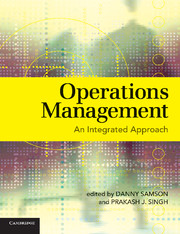Book contents
- Frontmatter
- Contents
- List of Contributors
- Preface
- Acknowledgements
- Part I Operations within Organisations – Building Blocks
- Part II Approaches to Understanding OM
- Part III Moving Forward with OM – Creating Competitive Advantage
- Part IV Challenges and Opportunities in Operations
- Part V Case Studies
- 1 Innovation in the Biotechnology Sector: The Case of IDT Australia
- 2 New Zealand King Salmon: Value-Chain Innovation
- 3 Pilila Clothing Company Goes Lean
- 4 From Singapore to the World: Port Management in Singapore
- 5 Striving for Operations Excellence within Queensland Rail Supply Division
- 6 Should I Stay or Should I Go? Shiraishi Garments Company
- 7 Towards a Green Supply Chain: Toyota Australia
- 8 Process Analyses and Improvement at Bartter Enterprises
- 9 Operations Challenges at Firth Industries Limited, Wellington Division
- 10 Ford Motor Company: Moving Forward in Australia
- 11 Technology Transfer at Hero Honda
- 12 Why Is the Patient Resident Time so Long?: The Case of St Martin's and Charity Private Hospital
- Index
4 - From Singapore to the World: Port Management in Singapore
Published online by Cambridge University Press: 05 June 2012
- Frontmatter
- Contents
- List of Contributors
- Preface
- Acknowledgements
- Part I Operations within Organisations – Building Blocks
- Part II Approaches to Understanding OM
- Part III Moving Forward with OM – Creating Competitive Advantage
- Part IV Challenges and Opportunities in Operations
- Part V Case Studies
- 1 Innovation in the Biotechnology Sector: The Case of IDT Australia
- 2 New Zealand King Salmon: Value-Chain Innovation
- 3 Pilila Clothing Company Goes Lean
- 4 From Singapore to the World: Port Management in Singapore
- 5 Striving for Operations Excellence within Queensland Rail Supply Division
- 6 Should I Stay or Should I Go? Shiraishi Garments Company
- 7 Towards a Green Supply Chain: Toyota Australia
- 8 Process Analyses and Improvement at Bartter Enterprises
- 9 Operations Challenges at Firth Industries Limited, Wellington Division
- 10 Ford Motor Company: Moving Forward in Australia
- 11 Technology Transfer at Hero Honda
- 12 Why Is the Patient Resident Time so Long?: The Case of St Martin's and Charity Private Hospital
- Index
Summary
Introduction
PSA was previously called Port of Singapore Authority. Its mission and values statement is shown in Table cs4.1. Starting in 1964, PSA has now become much more than a giant Singapore-based shipping hub entity. In 2007, PSA handled tens of millions of TEUs, with volumes growing some 15 per cent from the previous year.
The signing of the contract to build and operate a major container port at the Panama Canal in March 2007 marked another milestone for PSA International (PSA) – it extends its global reach to yet another continent, the Americas. The new container port at the Panama Canal, the world's third busiest waterway, is slated to double Panama's port capacity and enhances PSA's position in the fast-growing trade between China and East Coast of America.
‘I am pleased that we have taken this important step to develop a major port facility on the Pacific coast, in tandem with the widening and expansion of the Panama Canal, which is currently underway’, said PSA chief executive Eddie Teh.
Within a few years of its globalisation plan, PSA has extended its reach to 25 ports in 14 countries in Asia, Europe and now the Americas. For the first time in the group's history, its overseas terminals handled more container boxes (27.3 million) than the 24.0 million through-put at Singapore.
- Type
- Chapter
- Information
- Operations ManagementAn Integrated Approach, pp. 440 - 449Publisher: Cambridge University PressPrint publication year: 2008



